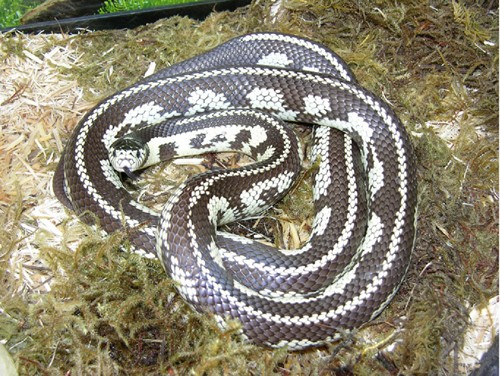Kingsnakes (Lampropeltis spp.)
Natural history
There are several species of kingsnake and their habitat and range vary. The Eastern kingsnake is found in humid forests of the eastern seaboard states and as far west as the Appalachians and Alabama. The California kingsnake is native to desert, arid grassland, and rocky hillsides of Baja Mexico and the western United States.
Pets may be bred in captivity or wild-caught. Kingsnakes are fairly docile, medium-sized, hardy reptiles, that make good “starter” snake pets.
Taxonomy
Class: Reptilia
Order: Squamata
Family: Colubridae – corn snake, rat snake
Lampropeltis getula californiae: California kingsnake
L. getula getula: Eastern kingsnake
Color and size
Hatchlings are gray with black dorsal saddles. Although an array of color morphs are available, adult Eastern kingsnakes are dark chocolate or black with white, cream, or yellow cross-bands.
This species is usually between 4-6 ft (1.2-1.8 m) in length, while California kingsnakes are usually 3-4 ft (0.9-1.2 m) long. The ground color of the California kingsnake is black or brown with a pattern of white, cream, or yellow stripes or bands.
Diet
Free-ranging kingsnakes prey upon rodents, lizards, and frogs and especially upon other snakes. Captive specimens will eat mice and small rats. An adult may be fed 1-3 mice once weekly. For more information, download the client handout: Feeding Snakes.
Husbandry
| Temperature | Provide a temperature gradient of 70-85°F (21-28°C) with a 10-15°F (2-5°C) drop at night. A winter cool-down or “brumation” is also recommended for healthy specimens. |
| Humidity/water | Provide a water bowl large enough for the snake to completely immerse its body, and heavy enough that the animal will not tip it over. Shedding may also be helped by the presence of a humidity box” or a hiding place filled halfway with damp sphagnum moss. Place the container half on and half off the heat. |
| Cage size and design | At minimum, adults require a long, 20-gallon (75-L) aquarium or terrarium. |
| Cage furniture/supplies | Provide visual security in the form of multiple hide boxes. Although kingsnakes are active, these terrestrial snakes do not require a climbing branch. Commercial substrate such as aspen bedding is recommended. |
| Social structure | Kingsnakes are solitary and will kill and eat other snakes. Similarly sized adults can be housed together for breeding, but are otherwise maintained separately in most cases. |
Lifespan
Most kingsnakes live 15+ years in captivity.
Sexually maturity is reached at approximately 200 g (7 oz) in males or 225 g (8 oz) in females. Kingsnakes are typically 18 months of age by this time.
Anatomy/ physiology
| Dermatologic: | Snakes lack movable eyelids; instead the eyes are protected by a clear “spectacle”, which is an embryonic fusion of the eyelids. The scaled skin is normally shed in one piece in a process called “ecdysis”. |
| Gastrointestinal: | The teeth are arranged in six rows with double rows present in the upper jaw. Snake teeth are shed through life, and are attached to the bone’s surface instead of roots. |
| Cardiopulmonary: | The snake’s three-chambered heart is mobile within the ribcage. Snakes possess incomplete tracheal rings. The right lung joins with a large air sac that may extend to the caudal coelom. The left lung is absent or vestigial. |
| Gastrointestinal: | The tongue is a complicated structure that sits within a pouch at the base of the oral cavity. The tip of the tongue is normally darker where the taste buds are found. Acrodont dentition: Teeth are not set in sockets, but instead are weakly attached to the jawbone surface. |
| Urogenital: | Snakes possess a renal portal system. Kingsnakes are “oviparous” or egg layers. |
| Sexual dimorphism: | The copulatory organs of the snake are “hemipenes”. Hemipenes lie within pouches at the ventral tail base. Probing of the male pouches will be deeper when compared to females. |
Restraint
Kingsnakes are relatively docile and rarely bite.
When handling a snake, take care not to smell like snake food (i.e. rodents or rabbits). Wash your hands thoroughly beforehand.
Support the head, neck, and body. Make sure the snake’s weight is not borne by its single occipital condyle and the cervical spine.
Tail vessel
Cardiac puncture
Injections
Give intramuscular injections between the scales in the epaxial muscles. Use the cranial half of the body to avoid the renal portal system.
Preventive medicine
Regular physical examination
Fecal parasite testing
Quarantine
Important medical conditions
Kingsnakes are relatively hardy species, however problems seen in captivity can include:
- Anorexia (juveniles of some species may refuse mice in preference of snakes or lizards)
- Dysecdysis, retained spectacles
- Egg binding or dystocia
- Endoparasitism (wild-caught)
- Pustular dermatitis or “blister disease”
**Login to view references**
References
References
Applegate R. Kingsnakes and Milksnakes in Captivity. ECO/Serpent’s Tale. 2007.
Bartlett RD, Bartlett PB, Griswold B. Reptiles, Amphibians, and Invertebrates: An Identification and Care Guide, 2nd ed. Hauppage, NY: Barron’s Educational Series; 2010.
De Vosjoli P. The Art of Keeping Snakes. Adv Viv Sys. 2004.
Perlowin D. The General Care and maintenance of Common Kingsnakes. Adv Viv Sys. 2009.
Raiti P. Captive care of the Common kingsnake, Lampropeltis getula. ARAV 5(1):9-10.
Pollock C. Basic information sheet: Kingsnakes. July 12, 2012. LafeberVet Web site. Available at https://lafeber.com/vet/basic-information-for-kingsnakes/
